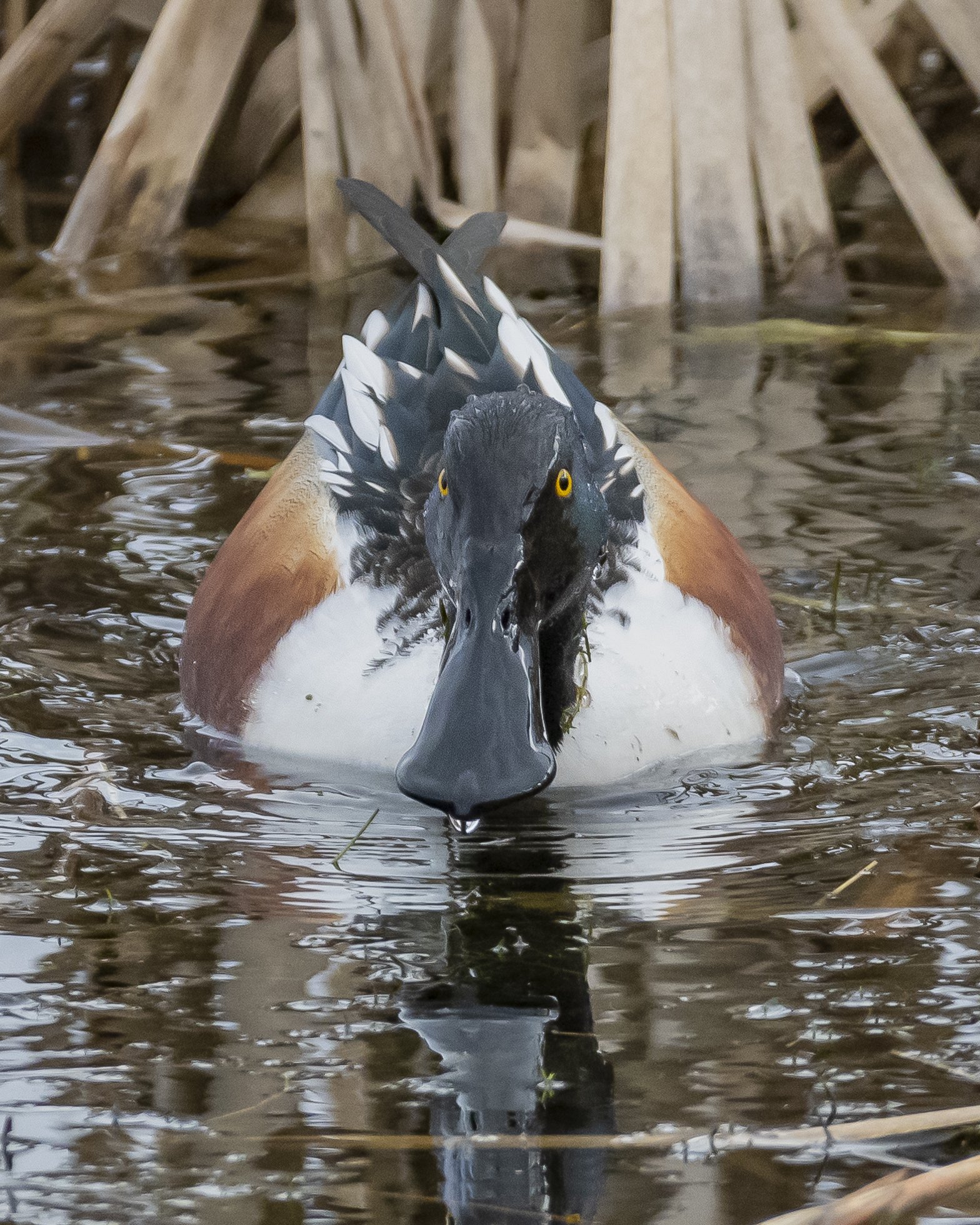We have had every sort of weather in March this year and it has kept us from straying far from home.
At the start of the month, himself was booked for a week to assist in some golf photography at the Sunningdale Foursomes. The weather forecast was not promising. After only one day he was back home. The competition was cancelled due to heavy snow.
Snowy Sunningdale in March (courtesy drone image from http://kevindiss.com/)
The rest of the month has been varied, snow, very strong winds, sleet, hail, heavy rain and in between all this a bit of sunshine, which, although brief, has now got a bit of strength and warmth to it.
A pretty Little Grebe was very busy outside a hide at Rutland Water.
There must have been a shoal of fish in the shallows in front of the hide at Rutland Water as two Cormorants tried fishing there but only one was successful.
Shoveler Ducks are quite unique with their flat bills. Shovelers feed by sweeping their large, flat bills back and forth through the water, filtering out small invertebrates, plant seeds and other plant matter. They are quite handsome ducks in their own way
A lone Snipe was bobbing about in the reeds. Usually we see large quantities of these around the reserve at Rutland but not many about on this particular day. In fact birds were very few and scarce when we visited. There is a feeding station just outside the visitor centre at Oakham and this is usually teeming with small birds but it was worryingly empty, not even a sparrow.
The volunteers in the centre were eagerly awaiting the return of the Ospreys from Africa, each one, of course, wanting to be the first to see them.
Just after we visited, Osprey 33 returned on the 16th March to the Manton Bay Osprey nest. The pair of Ospreys, female Maya and male 33(11) have bred together since 2015 and have raised 20 chicks during that time.
This year there is two live streaming webcams showing different angles of the nest, both of which incorporate sound so make sure to turn the volume up!
To find out more about the Ospreys and their reintroduction back to the UK please use the link https://www.lrwt.org.uk/rutlandospreys/about-rutland-ospreys
We will endeavour to get some Osprey images later in the year.
We headed off to Burwell fen to see if we could glimpse the Short Eared Owls before they headed back north to their breeding grounds. We spotted a couple but they were along way off, and the Barn Owl did not show this time. However, the resident Little Owl was on his usual log pile.
On this particular day there were quite a few Roe Deer about on the fen.
The KoniK ponies were grazing elsewhere but the Highland cattle were about and they always give us inquisitive looks. They are real characters. How do they ever see where they are going?
A trip back to his past for himself and a visit to Yaxley Church, Peregrine Spotting.
The Male, called locally VJP from his ring, is now currently residing on the tower of St Peter's Church, Yaxley. From the information on the rings he is known to be born in 2021 at All Saints Church in Stamford. So he hasn’t traveled too far.
The Church wardens have arranged for a nesting git tray to be installed on the tower. Three females have been spotted taking an interest so hopefully one of them will take his eye.
Did you know …… A male peregrine falcon is called a 'tiercel', while females are simply referred to as 'falcons'.
Did you also know ……The word 'peregrine' comes from the archaic term for 'foreign' or 'wanderer'. Although they travel widely, their strong homing instinct means they nearly always return to their favoured lands.
When you have an itch you have to scratch it, even if you are at the top of a church spire in gusting winds.
Peregrines are among the fastest animals on the planet, reaching speeds of up to 200 miles per hour when 'stooping' - diving down on its prey from a great height. Prey is usually taken mid-air and consists mostly of birds like pigeons and collared doves.
This is not a Peregrine in a “stoop”, more like a leisurely glide, much easier to photograph.
Take off! watch out pigeons.
We will definitely be keeping track of the Yaxley Peregrines via their own Facebook page and visiting them again. Watch this space……….
Such a fantastic morning watching Marsh Harriers at Wood Walton Fen. There were at least six birds out there displaying and nest building and generally showing off to each other. Absolutely fabulous.
Half a century ago, an opportunity to glimpse the marsh harrier’s spring courtship would have been an exceptional privilege. In 1971, the marsh harrier was Britain’s rarest breeding bird of prey: just one pair nested at Minsmere in Suffolk that year.
The species – along with other raptors, such as the Peregrine Falcon – had been all but wiped out by the widespread use of agricultural pesticides, including the now-infamous DDT, which built up in the birds’ bodies. Coming after a century and a half of extensive habitat destruction and relentless persecution, this was very nearly the final nail in the coffin.
Thankfully us humans woke up and a gradual withdrawal of insidious insecticides, stronger legal protection and the redevelopment of wetland habitats paved the way for a long-term revival.
So grateful to all involved with saving these beautiful birds.
One in, one out. All the reed bed and they both want the same spot.
Marsh Harrier showing the typical “V” shape of the wings when in flight.
So, another place we will going back to. We are going to have a busy April.
















